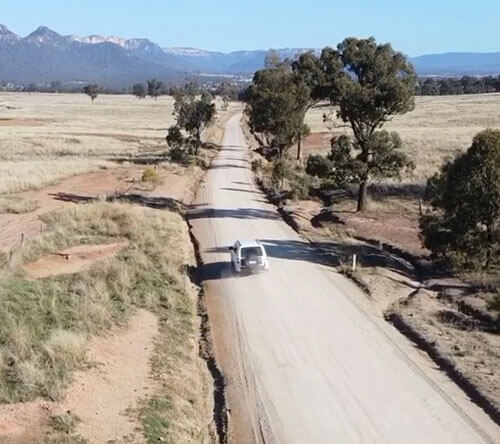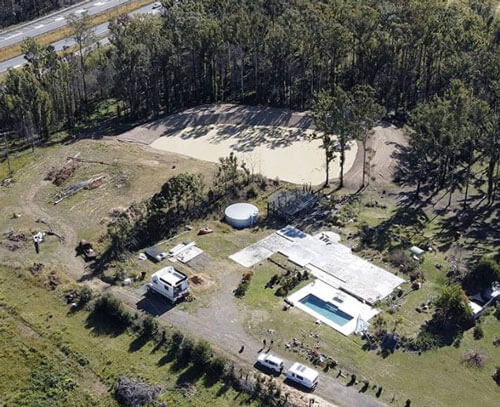Written by Jiri Lev, edited by the Australian Institute of Architects
Jiri Lev is an Australian building and urban designer. He has been working with the Australian Institute of Architects on the Architects Assist program, a network set up for architects who wish to help affected Australians rebuild after the devastating summer bushfires. In this piece, Jiri details his recent visit to some of these communities in need.
It has been disheartening to see the coronavirus outbreak obstruct the bushfire recovery. As those in the greatest need of Architects Assist (AA) services may not have heard of us, my wife and I decided to undertake a tour across the regions affected by the fires to raise awareness of AA services and make referrals to the generous Institute members who joined the AA community.

Leaving Tasmania
We’d booked and cancelled our ferry tickets to the mainland three times, before my wife Aleksandra, our baby son Franky and I were finally granted the required and ever-changing border permits. Restricted to the confines of our cabin, we crossed the Bass Strait on a strangely empty Spirit of Tasmania ferry. Arriving in Melbourne in the early morning of 25 July, we drove directly to the NSW border to comply with our permit conditions. Melbourne was quiet in the virus lockdown.
We began to see large swathes of recovering burnt bushland. Close to the NSW border we had to refuel at Mallacoota. Here just a few months ago, people and animals were pushed out onto the beach by raging fire. 110 homes were lost. The weight of the trauma could still be felt. Just before sunset in this deserted, burnt bushland we were slowly coming to halt at the NSW border checkpoint, acutely aware that this trip was going to be no holiday.
Southern NSW and Blue Mountains
The police said that only a handful of vehicles attempted to cross the NSW border daily. They were not familiar with our type of permit. Surrounded by detectives, army and navy personnel, we had our story, papers and purpose scrutinised. Some phone calls and a long while later we were free to continue. Though not before a friendly chat with now smiling officers, enquiring about Architects Assist services and taking some of our flyers home to their communities.
Near Kiah, where 220 homes were lost, we saw many people still living in tents and other temporary shelters. The regrowth on trees, recent roadkill and new roadside rubbish all signalled that the land is slowly coming back to normal. Progressing through landscapes alternating between totally destroyed, well recovering and completely unharmed, we began noticing a repeating pattern; the worst affected areas we saw were almost invariably commercial monoculture forestries and wild regrowth forests, where previously cleared land had been allowed to reforest all at once, without further management and thinning. When eucalyptus trees reach certain size and crowns start interlocking, they get stunted. This prevents the establishment of separated layers of canopy. Compared to a diverse forest or well-maintained cultural landscape, the thin, dense sticks of the forestries and regrowth forest look and burn like kindling.

Crossing the Snowy Mountains, we arrived in Batlow, where 140 homes were lost. Ruins of some buildings in the town centre are yet to be cleared. A man stopped us for a classic country chat in the middle of an intersection. It was encouraging to learn that he had heard of AA before. He hopes to rebuild his home better, with help from our architects. He is anxious to see his neighbours do the same. He is worried about the number of generic, poor quality prefab structures being erected in his neighbourhood.
Blanket logging activity in the surrounding forestries is omnipresent in a rush to harvest all the burnt lumber before Christmas, while it’s still usable. In Tumbarumba we first learned about another painful aspect of life after the fires; with the initial frantic recovery work now slowing down and with more time to think, many people have only just begun to feel the full emotional weight of their experiences, sometimes leading to the most tragic consequences. This has since been a common narrative. The communities are planning an upcoming series of talks and workshops and will be reaching out to our members with requests for assistance.
Back on the coast, we met an elderly gentleman who lost his miner’s cottage in the fires and was unable to afford design services in order to be able to apply for rebuilding grants. Nearby, a hardworking single mother was left in a similar predicament. Without help, people like these would be forced into often poorly designed, dysfunctional project homes and sheds. Architects Assist contributors are not first responders, nor are they saving lives, but by our simple, accessible service, we hope to right the distorted perception of architecture as an expensive and exclusive service.
Onward
As we progress North, we continue taking calls, visiting people in remote communities, listening to stories, making referrals and documenting burnt out sites for architects.
We’re also learning about more and more projects that started through Architects Assist, many in well advanced stages. It’s a privilege to be part of such a generous and kind group of professionals.
